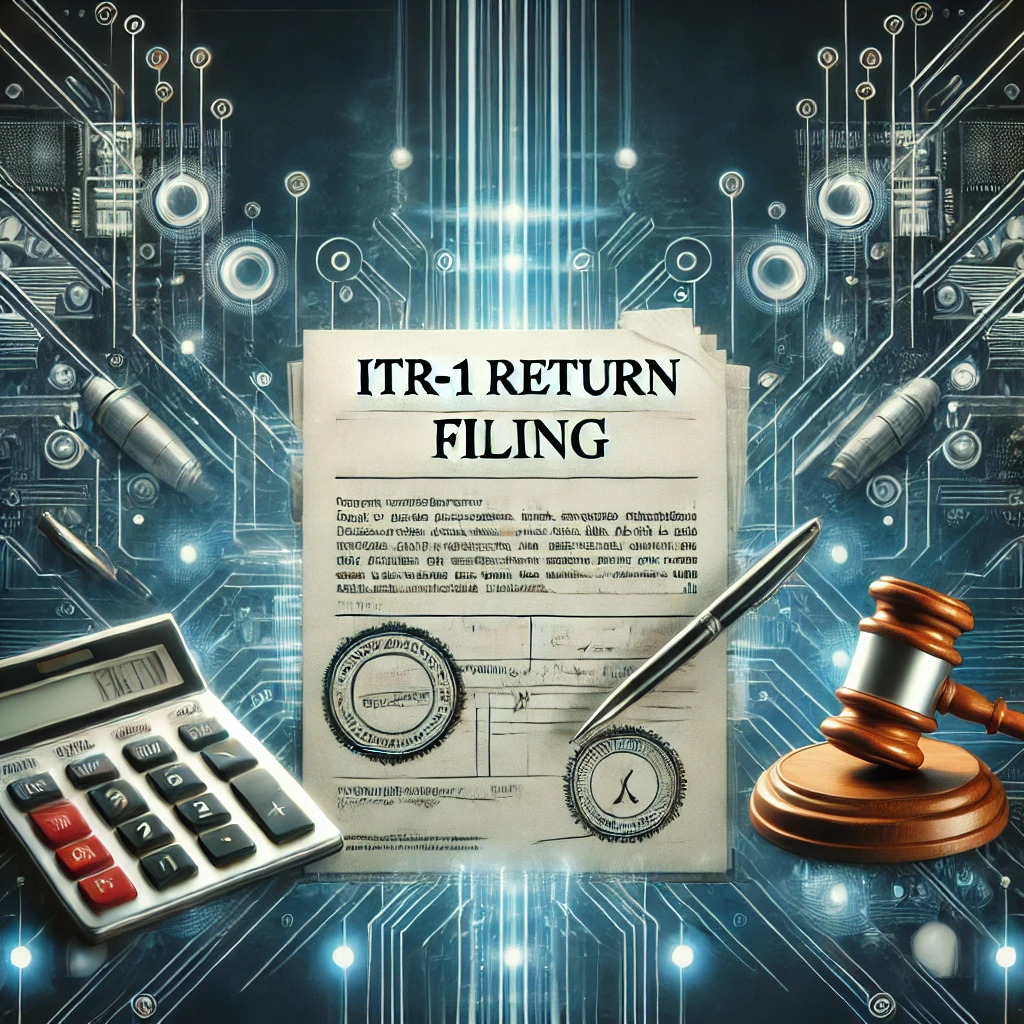Start Business
Start Business
Registration & License
Registration & License
Trademark Filing
Trademark Filing
Goods & Service Tax
Goods & Service Tax
Income Tax
Income Tax
MCA Services
Tender Registration
Tender Registration
Others
ITR-1 Return Filing in India – Simplified Tax Return for Salaried Individuals & Pensioners
Best & Reasonable Plans
Smart solutions,fair prices - your success starts with the Innovative solutions, competitive pricing – your journey to success begins with the perfect balance for growth!

OVERVIEW
ITR-1, also known as Sahaj, is a simplified income tax return form designed for resident individuals with straightforward income sources. It is applicable to those earning up to ₹50 lakh from salary, pension, one house property, and other sources such as interest income. This form is best suited for salaried individuals and pensioners who do not have complex financial transactions or business income.
Filing ITR-1 ensures compliance with tax regulations and helps individuals claim deductions, refunds, and exemptions seamlessly. The online filing process has made it more accessible, allowing taxpayers to submit their returns quickly through the Income Tax Department’s e-filing portal or authorized platforms. By filing ITR-1 on time, individuals can avoid penalties, avail tax benefits, and maintain a clean financial record.
Key Features Of ITR-1 Return Filing
- • Easy and Quick Filing : ITR-1 is simple to file with minimal documentation. It is best suited for salaried individuals and pensioners, allowing them to report their income effortlessly through online portals.
- • Tax Deductions & Savings : Taxpayers can claim deductions under Sections 80C, 80D, and 80G, reducing their taxable income. Those earning up to ₹5 lakh can also benefit from rebates under Section 87A.
- • Faster Refunds & Compliance Benefits : Filing ITR-1 on time ensures quick tax refunds and avoids penalties. It also helps in securing loans, credit approvals, and maintaining a strong financial profile.
What is ITR-1?
ITR-1, also known as Sahaj, is a simplified income tax return form introduced by the Income Tax Department of India for individual taxpayers. It is specifically designed for resident individuals with a total annual income of up to ₹50 lakh, making it one of the most commonly used tax forms. This form is meant for salaried employees and pensioners who have a straightforward financial structure, ensuring an easy and hassle-free tax filing process.
ITR-1 applies to individuals earning income from salary or pension, one house property (excluding cases of brought forward losses), and other sources such as interest from savings accounts, fixed deposits, and dividends. It does not apply to individuals with business or professional income, capital gains, foreign assets, or agricultural income exceeding ₹5,000. Additionally, Hindu Undivided Families (HUFs) and Non-Resident Indians (NRIs) are not eligible to file ITR-1.
Filing ITR-1 is essential for tax compliance and financial credibility. By submitting this return, taxpayers can report their income, claim deductions, and pay taxes as per applicable laws. It also allows individuals to claim tax refunds if excess Tax Deducted at Source (TDS) has been deducted from their income. Moreover, timely filing of ITR-1 helps in availing tax benefits under sections like 80C (investments), 80D (health insurance), and 80G (donations), reducing overall tax liability.
Beyond tax savings, filing ITR-1 also plays a crucial role in financial planning. It serves as proof of income, which is often required for loan approvals, credit card applications, and visa processing. The government has simplified the process by offering online filing options, making it more accessible and efficient. Filing on time ensures quick processing, prevents penalties, and maintains a clean tax record, securing financial stability for the future.
Who Can File ITR-1?
Salaried Individuals and Pensioners
Individuals earning a fixed salary from an employer or receiving a pension after retirement are eligible to file ITR-1. Their primary source of income should be from employment or pension funds.
Individuals with Income from One House Property
Taxpayers who own only one residential property and earn rental income from it (or use it for self-occupation) can file ITR-1. However, it is not applicable if they have brought forward losses from previous years under the house property category.
Individuals Earning Interest or Other Passive Income
If an individual earns additional income from bank interest (savings accounts, fixed deposits, recurring deposits), post office interest, or dividends, they can declare it under ITR-1. However, income from speculative trading or other business activities is not allowed under this form.
Individuals Claiming Deductions Under 80C, 80D, and 80G
Taxpayers who want to claim deductions for investments in PPF, EPF, LIC, ELSS mutual funds (80C), medical insurance (80D), or donations (80G) can file ITR-1. These deductions help reduce taxable income and lower the overall tax liability.
Who Cannot File ITR-1?
Non-Resident Individuals (NRIs) and Hindu Undivided Families (HUFs)
ITR-1 is strictly meant for resident individuals. Non-Resident Indians (NRIs) and Hindu Undivided Families (HUFs) cannot use this form and must opt for ITR-2 or ITR-3, depending on their income structure.
Individuals with Business or Professional Income
Those earning income from business, freelancing, or professional services (such as doctors, lawyers, consultants, or small business owners) are not eligible to file ITR-1. They must use ITR-3 or ITR-4, which accommodate business income reporting.
Individuals with Capital Gains or Crypto Income
Anyone earning capital gains from the sale of stocks, property, mutual funds, or cryptocurrencies cannot file ITR-1. Instead, they must use ITR-2 or ITR-3 to report such earnings.
Individuals Owning Multiple House Properties
If an individual owns more than one house property, whether self-occupied or rented out, they cannot file ITR-1. Instead, they must choose ITR-2 or ITR-3, which allow for detailed property income reporting.
Individuals with Agricultural Income Above ₹5,000
Taxpayers earning agricultural income exceeding ₹5,000 must opt for ITR-2 instead of ITR-1. Lower agricultural incomes (below ₹5,000) can be reported under ITR-1.
Individuals with Foreign Income or Foreign Assets
Those earning income from foreign sources (such as salary from a foreign employer or rental income from property abroad) or owning foreign assets/bank accounts cannot use ITR-1. They must file ITR-2 or ITR-3 to comply with foreign asset declaration rules.
Silent Features
Designed for Salaried Individuals
Covers Income from One House Property
Allows Reporting of Interest and Other Income
Permits Tax Deductions Under Section 80C to 80U
Quick and Easy E-Filing Process
Not Applicable for High-Income Earners
Advantages of Filing ITR-1
- Simplified Filing Process: ITR-1 is designed for individuals with straightforward income sources, making it easy to fill and submit online without extensive documentation or calculations.
- Faster Processing and Refunds: Since ITR-1 involves minimal complexities, the Income Tax Department processes it quickly, ensuring faster tax refunds for eligible taxpayers.
- Legal Compliance and Avoidance of Penalties: Filing ITR-1 on time helps taxpayers stay legally compliant, avoiding penalties for late filing and ensuring smooth financial transactions.
- Helps in Loan and Credit Approvals: A filed ITR-1 serves as proof of income, which is essential when applying for loans, credit cards, or financial investments, improving credibility with banks and lenders.
- Eligibility for Tax Deductions: ITR-1 allows individuals to claim deductions under Sections 80C, 80D, and other exemptions, reducing taxable income and lowering tax liabilities.
- Proof of Financial Stability: A properly filed ITR-1 serves as financial documentation, which is helpful for visa applications, property purchases, and government benefits, showcasing financial discipline.
Documents Required
PAN Card
Aadhaar Card
Bank Statements
Form 16
Income Proofs
Form 26AS
Step-by-Step Guide For Income Tax Return (ITR) Filing
Here are 5 steps to complete your Income Tax Return (ITR) Filing
Step 1
Gather Required Documents
Step 2
Log in to the Income Tax Portal
Step 3
Select ITR-1 Form and Fill in Details
Step 4
Claim Deductions and Verify Tax Liability
Step 5
Verify and Submit Your ITR
Empowering Your Business to Stay Ahead


Ensuring excellence in every aspect of business operations

Helping businesses to stay ahead of the competition effectively

Providing expert guidance for long-term business growth





